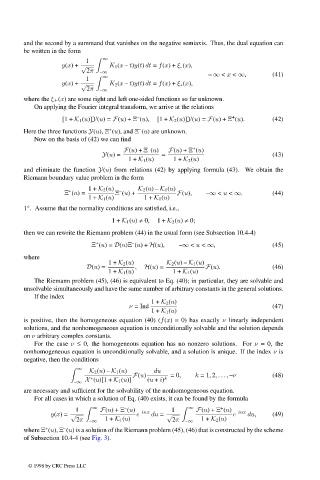Page 578 - Handbook Of Integral Equations
P. 578
and the second by a summand that vanishes on the negative semiaxis. Thus, the dual equation can
be written in the form
1 ∞
y(x)+ √ K 1 (x – t)y(t) dt = f(x)+ ξ – (x),
2π –∞
1 ∞ – ∞ < x < ∞, (41)
y(x)+ √ K 2 (x – t)y(t) dt = f(x)+ ξ + (x),
2π –∞
where the ξ ± (x) are some right and left one-sided functions so far unknown.
On applying the Fourier integral transform, we arrive at the relations
– +
[1 + K 1 (u)]Y(u)= F(u)+ Ξ (u), [1 + K 2 (u)]Y(u)= F(u)+ Ξ (u). (42)
–
+
Here the three functions Y(u), Ξ (u), and Ξ (u) are unknown.
Now on the basis of (42) we can find
–
+
F(u)+ Ξ (u) F(u)+ Ξ (u)
Y(u)= = (43)
1+ K 1 (u) 1+ K 2 (u)
and eliminate the function Y(u) from relations (42) by applying formula (43). We obtain the
Riemann boundary value problem in the form
1+ K 2 (u) – K 2 (u) – K 1 (u)
+
Ξ (u)= Ξ (u)+ F(u), –∞ < u < ∞. (44)
1+ K 1 (u) 1+ K 1 (u)
◦
1 . Assume that the normality conditions are satisfied, i.e.,
1+ K 1 (u) ≠ 0, 1 + K 2 (u) ≠ 0;
then we can rewrite the Riemann problem (44) in the usual form (see Subsection 10.4-4)
–
+
Ξ (u)= D(u)Ξ (u)+ H(u), –∞ < u < ∞, (45)
where
1+ K 2 (u) K 2 (u) – K 1 (u)
D(u)= , H(u)= F(u). (46)
1+ K 1 (u) 1+ K 1 (u)
The Riemann problem (45), (46) is equivalent to Eq. (40); in particular, they are solvable and
unsolvable simultaneously and have the same number of arbitrary constants in the general solutions.
If the index
1+ K 2 (u)
ν = Ind (47)
1+ K 1 (u)
is positive, then the homogeneous equation (40) (f(x) ≡ 0) has exactly ν linearly independent
solutions, and the nonhomogeneous equation is unconditionally solvable and the solution depends
on ν arbitrary complex constants.
For the case ν ≤ 0, the homogeneous equation has no nonzero solutions. For ν = 0, the
nonhomogeneous equation is unconditionally solvable, and a solution is unique. If the index ν is
negative, then the conditions
∞
K 2 (u) – K 1 (u) du
F(u) =0, k =1, 2, ... , –ν (48)
+
X (u)[1 + K 1 (u)] (u + i) k
–∞
are necessary and sufficient for the solvability of the nonhomogeneous equation.
For all cases in which a solution of Eq. (40) exists, it can be found by the formula
∞ – ∞ +
1 F(u)+ Ξ (u) –iux 1 F(u)+ Ξ (u) –iux
y(x)= √ e du = √ e du, (49)
2π –∞ 1+ K 1 (u) 2π –∞ 1+ K 2 (u)
–
+
where Ξ (u), Ξ (u) is a solution of the Riemann problem (45), (46) that is constructed by the scheme
of Subsection 10.4-4 (see Fig. 3).
© 1998 by CRC Press LLC
© 1998 by CRC Press LLC
Page 561

